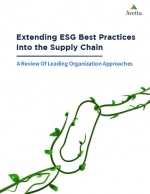Aligning Procurement and Environment, Health and Safety to Reduce Risk
This paper details three areas in which environmental, health, and safety expertise can be aligned with an organization’s procurement practices to create an arrangement that is beneficial for everyone.
Procurement and Risk
Procurement is a risky business. Procurement managers are responsible for obtaining materials, goods, and services at the lowest reasonable cost - and they are responsible for ensuring that the supplier or vendor reliably provides high-quality goods, in both the present and the future.
They must make sure that the organization does not knowingly or unknowingly engage in, support or turn a blind eye to criminal behavior, like bribery.
They must negotiate contractual agreements that protect the company against possible disputes, and the procurement process against fraud and theft. If the procurement process goes wrong at any point - for example, if a supplier cannot provide enough raw materials to support production demands, and no alternative is readily available - the entire organization could be harmed.
Add to those responsibilities and risks the expectation that organizations will commit themselves to corporate social responsibility (CSR), embracing business practices that value and account for more than just short-term financial performance.
Organizations that wish to thrive in a global economy need to look beyond their financial bottom line to their social and economic impacts.
One vital aspect of CSR is “ethical and sustainable procurement” - the principle that a corporation has a responsibility to hold its vendors and suppliers to acceptable standards for both worker and environmental protection.
Contracting with lower-cost suppliers outside the United States does not absolve an organization of responsibility for the way that its suppliers in foreign countries treat their workers and the environment.
As Nike and many other global corporations have discovered, consumers and shareholders know that a commitment to “ethical and sustainable” production methods that applies only to an organization’s domestic operations is a shallow commitment indeed.
But procurement managers are unlikely to have extensive expertise in environment, health, and safety (EHS) issues, so EHS professionals have an important role to play in identifying and mitigating the environmental, health, and safety-related risks affecting procurement.
Effectively addressing EHS concerns in the supply chain can make a significant contribution to procurement.
It’s also a win for EHS because it powerfully reinforces the value of EHS in the achievement of organizational objectives, including risk reduction.
What’s Related




Favorites





